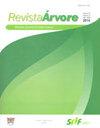GENETIC DIVERSITY IN AMBURANA (Amburana cearensis) ACCESSIONS: HIERARCHICAL AND OPTIMIZATION METHODS
IF 0.8
4区 农林科学
Q4 FORESTRY
引用次数: 1
Abstract
ABSTRACT The evaluation of accessions in a germplasm bank is essential for determining the potential parents in conservation programs, especially for native trees. This study aimed to determine the genetic diversity among 68 Amburana cearensis genotypes from different locations in the state of Pernambuco, Brazil. Their genetic patterns were evaluated by Inter Simple Sequence Repeat (ISSR) molecular markers and genetic divergence was evaluated through multivariate analyses using different clustering methods. The optimization method used (Tocher) was in agreement with all the hierarchical models used, in which clustering of the genotypes occurred similarly, specifically for the accession BB116, which is an important genetic material to be preserved and studied. Among the various hierarchical methods applied, the Average Linkage method exhibited higher discrimination power, allowing identification of a larger number of divergent groups, thus implying wide genetic diversity among A. cearensis accessions.黄颡鱼(AMBURANA cearensis)种质的遗传多样性:层次和优化方法
摘要对种质库中的材料进行评估对于确定保护计划中的潜在亲本至关重要,尤其是对本土树木而言。本研究旨在确定来自巴西伯南布哥州不同地区的68种雪兰基因型的遗传多样性。用ISSR分子标记评价其遗传模式,并用不同聚类方法进行多元分析评价其遗传差异。所使用的优化方法(Tocher)与所使用的所有层次模型一致,其中基因型的聚类发生相似,特别是对于要保存和研究的重要遗传物质BB116。在应用的各种层次方法中,平均连锁法表现出更高的辨别力,可以识别出更多的不同群体,从而意味着紫檀材料之间存在广泛的遗传多样性。
本文章由计算机程序翻译,如有差异,请以英文原文为准。
求助全文
约1分钟内获得全文
求助全文
来源期刊

Revista Arvore
FORESTRY-
CiteScore
1.00
自引率
0.00%
发文量
32
审稿时长
4-8 weeks
期刊介绍:
A Revista Árvore é um veículo de comunicação científica da Sociedade de Investigações Florestais – SIF. O jornal é de acesso gratuito, revisado por pares, que publica bimestralmente trabalhos científicos originais no campo da Ciência Florestal. As áreas temáticas para publicação são: Ambiência e Conservação da Natureza, Manejo Florestal, Silvicultura e Tecnologia da Madeira e Utilização de Produtos Florestais.
A política editorial visa manter alta conduta ética em relação à publicação e aos seus funcionários, rigor na qualidade dos artigos científicos, seleção de revisores qualificados, respeito profissional aos autores e processo de tomada de decisão imparcial. A Revista Árvore publica artigos apenas em inglês.
Artigos de revisão podem ser publicados se houver uma discussão relevante resumindo o estado da arte sobre o assunto. A revisão estrita da literatura não é aceita.
 求助内容:
求助内容: 应助结果提醒方式:
应助结果提醒方式:


